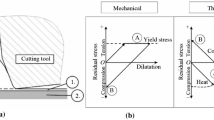Abstract
Based on the Oxley-Welsh theory, this paper focuses on the influence of strain-hardening behavior of oil country tubular goods (OCTG) 40CrMnMo (workpiece material) on a cutting model and the influence of cutting parameters on a stress distribution in the shear zone and the chip formation in turning processes by establishing a reasonable cutting experimental platform. Then a relationship model between the shear flow stress and the hydrostatic stress in the shear zone is built, and the size effect and strain-hardening effect of the shear zone in the turning process are explained reasonably, especially for the influence of them on the chip morphology. The research results show that the slope K of the relationship model is not caused by the Bridgman effect but results from a synergistic action of the size effect and the strain-hardening effect in the shear zone of the workpiece material. The workpiece 40CrMnMo in the shear zone can obtain a better resistance to the inhomogeneous plastic deformation under a certain cutting condition.
Similar content being viewed by others
References
Yu HY (2012) Comparative study on strain hardening models of thin metal sheet. Forging Stamping Technol 37(5):1–6
Yang RC, Xia Y, Hu TL, Zhang AM (2011) Tensile strain hardening behavior of several kinds of stainless steels. J Lanzhou Univ Technol 37(1):5–8
Mo DF, He GQ, Hu ZF, Liu XS, Zhang WH (2010) Effect of microstructures on strain hardening exponent prediction of cast aluminum alloy. Acta Metall Sin 46(2):184–188
Yang Y, Zhu WW, Li M (2014) Construction of material constitutive model during cutting process for aeronautical titanium alloy based on orthogonal cutting theory. Chin J Nonferrous Met 24(5):1259–1267
Nobre JP, Batista AC, Coelho L, Dias AM (2010) Two experimental methods to determining stress-strain behavior of work-hardened surface layers of metallic components. J Mater Process Technol 210:2285–2291
Rojacz H, Mozdzen G, Winkelmann H (2014) Deformation and strain hardening of different steels in impact dominated systems. Mater Charact 90(4):151–163
D'Urso G, Attanasio A (2011) Analytical and numerical modeling of strain hardening in AISI 304 steel cutting. Adv Mater Res 223(5):381–390
Childs THC, Rahmad R (2009) Modelling orthogonal machining of carbon steels. Part II: strain hardening and yield delay effects. Int J Mech Sci 51(6):402–411
Nasr MNA, Ng EG, Elbestawi MA (2007) Effects of strain hardening and initial yield strength on machining-induced residual stresses. J Eng Mater Technol 129(4):567–579
Liu ZQ, Wu JH, Shi ZY, Zhao PF (2008) State-of-the-art constitutive equation in metal cutting operations. Tool Eng 42(3):3–9
Meng LF, Hu CL, Zhao Z (2014) Research progress of friction model in metal plastic forming. Die Mould Ind 40(4):1–7
Shi ZH, Xu YQ, Guo CH, Zhao JH (2012) Analysis of interface stresses of coated tool under friction on rake and flank faces. Tool Eng 46(9):14–19
Fu YH, Xiao KL, Ha XJ, Yuan ZC, Yang YG (2013) Cutting trial and performance analysis of surface micro-grooves turning tools. China Surf Eng 26(6):106–111
Pan YZ, Ai X, Tang ZT, Zhao J (2008) Optimization of tool geometry and cutting parameters based on a predictive model of cutting force. China Mech Eng 19(4):428–431
Wu Z, Deng JX, Pian T, Lian XS, Zhao J (2011) Study on cutting performance with micro-texturing self-lubricated tools. Tool Eng 45(7):18–22
Sugita N, Ishii K, Furusho T, Harada K, Mitsuishi M (2015) Cutting temperature measurement by a micro-sensor array integrated on the rake face of a cutting tool. CIRP Ann Manuf Technol 64(1):77–78
Sulaiman S, Roshan A, Borazjani S (2013) Effect of cutting parameters on cutting temperature of TiAL6V4 alloy. Appl Mech Mater 392(7):68–72
Satheeshkumar V, Narayanan RG (2014) In-plane plane strain formation of adhesive-bonded steel sheets: influence of adhesive properties. Int J Adv Manuf Technol 76(6):993–1009
Shamoto E, Kato M, Suzuki N, Hino R (2013) Analysis of three-dimensional cutting process with thin shear plane model. J Manuf Sci Eng 135(4):41001
Che D, Ehmann K, Cao J (2015) Analytical modeling of heat transfer in polycrystalline diamond compact cutters in rock turning processes. J Manuf Sci Eng 137(3):31005
Li KM, Liang SY (2006) Modeling of cutting temperature in near dry machining. J Manuf Sci Eng 128(2):416–424
Ren XP, Liu ZQ (2016) Influence of cutting parameters on work hardening behavior of surface layer during turning superalloy Inconel 718. Int J Adv Manuf Technol 2016(1):1–9
Thakur DG, Ramamoorthy B, Vijayaraghavan L (2012) Effect of cutting parameters on the degree of work hardening and tool life during high-speed machining of Inconel 718. Int J Adv Manuf Technol 59(6):483–489
Li LY, Li X, He Z (2012) 3D-FE simulation of inhomogeneous stress and strain distributions in cold profiled ring rolling process under different hardening coefficients. Int J Mater Prod Technol 44(2):47–66
Joo G, Huh H, Choi MK (2016) Tension/ compression hardening behaviors of anto-body steel at intermediate strain rates. Int J Mech Sci 109(4):174–187
Author information
Authors and Affiliations
Corresponding author
Rights and permissions
About this article
Cite this article
Jiang, H., He, L., Zou, Z. et al. Experimental research on strain-hardening effect of 40CrMnMo in turning process based on the Oxley-Welsh theory. Int J Adv Manuf Technol 93, 3053–3061 (2017). https://doi.org/10.1007/s00170-017-0655-9
Received:
Accepted:
Published:
Issue Date:
DOI: https://doi.org/10.1007/s00170-017-0655-9



